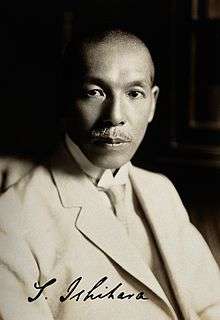Shinobu Ishihara

Shinobu Ishihara (石原忍, Ishihara Shinobu, Tokyo, September 25, 1879 - Izu Peninsula, January 3, 1963) was a Japanese ophthalmologist who created the Ishihara color test to detect colour blindness. He was an army surgeon.
Early life and career
Ishihara graduated from medicine in 1905 on a military scholarship[1] and immediately joined the Imperial Japanese Army as a doctor, serving mainly as a surgeon. He later changed specialties to ophthalmology. In 1908 he returned to the University of Tokyo where he dedicated himself to ophthalmic research. In 1910 he became an instructor at the Army Medical College. There, in addition to seeing patients, he conducted research on "battlefield ophthalmology" and how to select superior soldiers. While working at the Military Medical School he was asked to devise a test to screen military recruits for abnormalities of color vision. His assistant was a color blind physician who helped him test the plates. The first charts were hand painted by Ishihara in water colors using hiragana symbols.
Ishihara Color Vision Test
The name Ishihara is known worldwide because of the Ishihara Color Vision charts which he established in 1918. Even today, his test remains the one of choice throughout the world. Ishihara developed a Japanese visual acuity chart and an apparatus for determining the near point, both currently in wide use in Japan. He also made significant contributions to the study of trachoma and myopia.
In 1908, Ishihara entered the postgraduate course in ophthalmology at the Imperial University of Tokyo, studying under Prof. Jujiro Komoto. Subsequently, he studied in Germany under Professors Wolfgang Stock, Theodor Axenfeld and Carl von Hess. Ishihara was appointed the professor and chairman, to succeed Prof. Komoto, at the Ophthalmology Department of the Imperial University of Tokyo in 1922 and served until March 1940.
Personal life
Ishihara led a very modest life, with no interest in material possessions. He was greatly revered by his students who, after his retirement, built a cottage for him near a hot spring on the Izu Peninsula. There he served as a country doctor, conducting clinics for his neighbors, asking no payment. As was the custom in those days, patients left tokens of their gratitude in home-grown produce and small sums of money. After covering his expenses, Ishihara returned all remaining money to the villagers. These funds were used to build a library and a study room for the village children, a fitting tribute to the highly respected benefactor who came to live in their midst until his death in 1963.[2]
References
- ↑ "Shinobu Ishihara". Whonamedit? ; A dictionary of medical eponyms. Retrieved 3 December 2013.
- ↑ Japanese Journal Of Ophthalmology, volume 38, issue 1. 1994